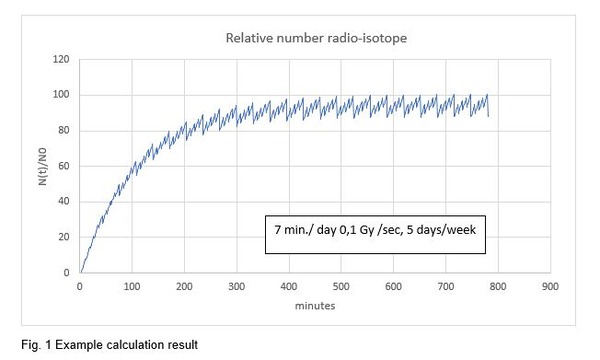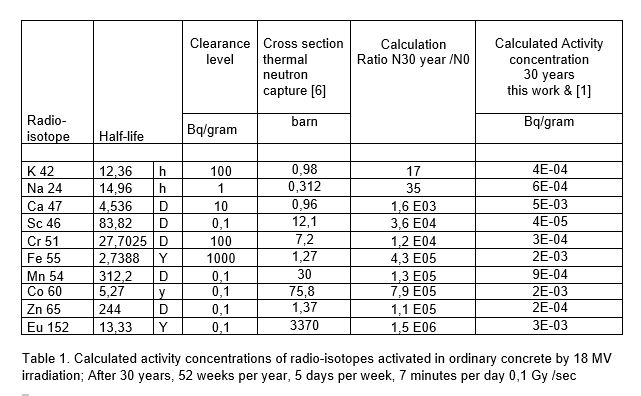concrete activation-concentrations in a high energy medical accelerator bunker: a case study
Marielle van Hinsberg,
The Netherlands
PO-1786
Abstract
concrete activation-concentrations in a high energy medical accelerator bunker: a case study
Authors: Marielle van Hinsberg1
1ZRTI, Klinische Fysica, Vlissingen, The Netherlands
Show Affiliations
Hide Affiliations
Purpose or Objective
Euratom directives implemented in Dutch regulations ask for special attention to all kinds of sources of radioactive waste, accumulated during the life-time of a high energy accelerator facility. Neutrons created by high energy photons in the head of LINAC will active the concrete shielding (neutron capture). Clearance levels for radioactive waste depend on the activation concentration for each radio-isotope present. The objective of this case-study is to estimate the order of magnitude of activation-concentrations of radio-isotopes in concrete for a 30 year old, clinically used radiotherapy bunker and confirm this estimate with gamma spectroscopy measurements.
Material and Methods
The bunker under investigation has been used for treating patients successively on a dual (6 MV-18MV) energy LINACs between 1992 and 2022. The shielding is made of ordinary concrete.
The number of radio-isotopes after 30 years for several radio isotopes has been determined by calculating the netto result after historic activations and subsequent decay. The algorithm is validated with published data [1] for Mn54 , using neutron flux data from NCRP 151/ literature [2][3].
A maximum irradiation time for 18 MV beams during this period has been estimated and for this purpose, distributed equally over time during operational hours. Calculations are performed for concrete in the floor, which is nearest to the neutron-source in the head of the LINAC.
The conversion to activity concentration for each radio-isotope is based on measurements from Žagar et al [l].
Finally 6 concrete samples have been analyzed [5] using gamma-ray spectroscopy, 20 days after a final 1 Gy 18 MV-irradiation at dmax.
Results
A total irradiation time of 939 hours has been estimated or daily irradiations of 7 minutes at 0.1 Gy/sec, 5 days a week. An example of a calculation is shown in figure 1.

Calculated activity concentration for several radio-isotopes present, are shown in table 1. After 20 days the remaining activity of the 1 Gy irradiation is predicted to be less than 0.1 Bq/gram. Gamma-ray spectroscopy measurements show no detectable activity of the radioisotopes in table 1.

Conclusion
After 30 years of normal clinical use no radioactive waste due to 18 MV irradiations is present in the concrete shielding of this radiotherapy bunker.
References
[1] Žagar T., Ravnik M., Measurement of neutron activation in concrete samples International Conference Nuclear Energy in Central Europe 2000
[2] NCRP Report No.151, Structural Shielding Design and Evaluation for Megavoltage X- and gamma-ray radiotherapy facilities, 2012
[3] Banaee N. et al, Neutron contamination in radiotherapy processes: a review study
Journal of Radiation Research, 62 (6), November 2021, Pages 947–954
[4] Lee D.-Y. Kim J.-H. Evaluating activation of the shielding walls of a treatment room using the Monte Carlo method, Journal of Instrumentation 13(05), May 2018
[5] NRG, Westerduinweg 3, 1755 LE Petten, the Netherlands
[6] https://www-nds.iaea.org/relnsd/NdsEnsdf/neutroncs.html